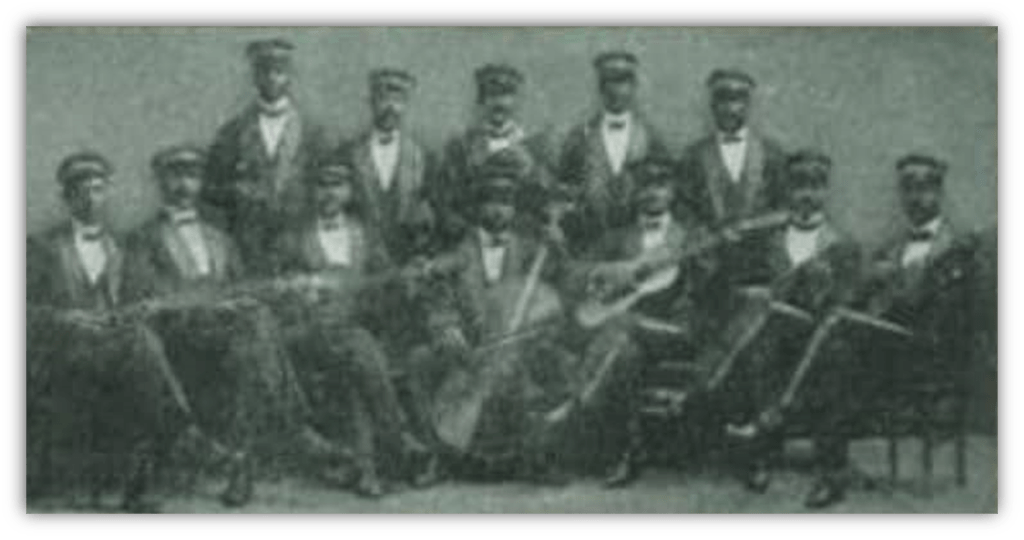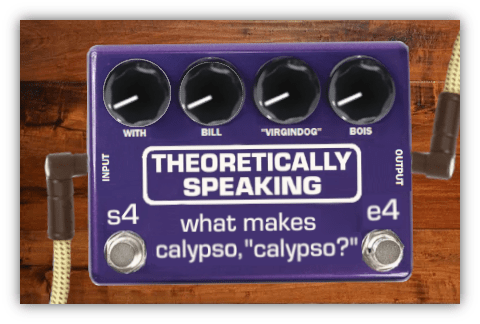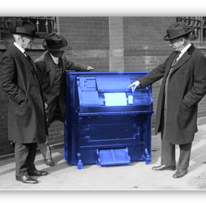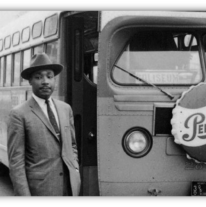It’s a familiar story.
Thousands of people are kidnapped and sent to another continent where they’re enslaved for life, and their children’s’ lives, and their grandchildren’s’ lives.
Since the enslaved people are from different countries but they’re thrown together onto plantations, some traditions survive, others don’t, and new ones develop.

Songs from their homelands are passed down through generations but also pick up the influence of local music, and even the masters’ music.
Lyrics are cleverly worded to talk about the masters behind their backs.
But this story isn’t about the American South.
It’s about Trinidad.

One of the southernmost and easternmost Caribbean islands. It’s less than a dozen miles from Venezuela, which has its own influence later in this story.
The slaves were African and the masters were French planters who settled there to grow sugar, coffee, cotton, and cacao.
The French were gradually replaced by the English, and the Africans adapted. They learned to speak first one language and then the other, since they weren’t allowed to speak their own, but they sang in their own French Creole patois or pidgin English to make the songs’ meanings hard for outsiders to understand.

They communicated through dance, too, and used it and music to convey their despair and hope for freedom.
The music the people from Nigeria brought with them is called kaiso, which is a concatenation of the words “ka,” meaning “go,” and “iso,” meaning “forward.”
It’s sort of a dance instruction, and was often said as someone danced their way under a horizontal stick. Then the stick would be lowered to make passage underneath more difficult. It became a competition to see who could go under the lowest stick without falling.
We know it as limbo.

There’s some evidence that suggests limbo was used on the slave ships as a form of exercise, so the Africans would be in good shape when they arrived at the market.
The sticks, in this case, were the bamboo-like stalks of the sugar cane plants being grown on the island. These sticks were also used as percussion instruments and for stick fighting, a sort of combination of dance and martial arts accompanied by kalinda drumming, which came from Congo and Angola. The long-long-short kalinda rhythm, full of triplets, can still be heard, pretty much unchanged, in Calypso and its current day descendant Soca.
However, as the British took over from the French, they banned the kalinda drum. They knew it was being used for communication and thought it could lead to organized uprisings against their rule.
In the same way that the Africans changed French and English into their own dialects, they adapted to losing the kalinda drum. They just invented new instruments.
One of these instruments came much later, in the 1930s, and is a very recognizable characteristic of Calypso.
It’s a steel oil barrel turned upside down, and hit with wood or metal sticks. The bottom is bent into a concave shape with small areas pounded to different thicknesses. Each of these areas plays a different note when hit.

It’s called the steel drum or steelpan, and it was cheap to make because there were barrels everywhere once oil was discovered.
As the instrument and its tuning were perfected, it became a familiar sound in Calypso, Soca, and Reggae.
Trinidad had abolished slavery in 1834 and that affected the music in a couple ways. Its new freedom attracted people from as far away as India. They brought their own traditions. Also, Trinidadians could travel elsewhere and bring new ideas home.

With Venezuela just off the coast, it was just a matter of time before their music was integrated.
Venezuelan string bands used guitars, violins, and cellos, in addition to horns and drums, to create upbeat dance music. These instruments played over the syncopated kalinda rhythm is the start of true Calypso.
The first recording of anything we can call Calypso is by Lovey’s String Band.
They went to New York City in 1912 and recorded in a studio there. The first Calypso music recorded locally in Trinidad was by Jules Sims in 1914. They’re the first two items in Suggested Listening below.
By the 1930s, Calypso had become competitive and artists gave themselves larger than life names, like Lord Kitchner, The Mighty Sparrow, and Roaring Lion. These Calypsonians, as they called themselves, wrote lyrics about injustice and inequality. They would criticize politicians, expose corruption, and promote social change.
It was also a source of news. An amazing example is “Invasion Of Poland “ by Roaring Lion. He wrote it in 1939, shortly after Germany’s invasion of Poland at the beginning of World War II. It was a statement of solidarity with the Polish people and their struggle against the Nazis, and it quickly became popular among Trinidadians and other West Indians who were following the war closely.
The song’s broader message is about resisting oppression of any sort. It’s an amazing artifact:
There were fun, danceable songs, too, full of double entendre and innuendo.
These could be about banana boats or beautiful women named Maryann down by the seaside sifting sand. Regardless of subject matter, the music was always upbeat, witty, and catchy.
By the 1940s, the influence of American big bands came in, and Calypso took in elements of jazz and swing. Some arrangements got very intricate, the tempos got faster like in be bop, and artists started improvising both lyrics and instrumental solos.
During WWII, American soldiers stationed on the island caught the Calypso bug and brought the records home. There, The Andrews Sisters had a hit with a cover of the Lord Invader song “Rum and Coca Cola.”
The artist that made the biggest impact in America was, of course, Harry Belafonte, who died just last month.
That’s why I picked Calypso for our topic this week.

His “Banana Boat Song” was a huge hit in the States, and it helped popularize Calypso music worldwide. He added crooning to his repertoire, which only increased his popularity in America.
Intelligent, talented, and devastatingly good looking, he had many hits, acted in Hollywood movies, and became a human rights activist.
Once he and other artists started appearing in movies, Calypso became a global phenomenon, and its influence could be seen in other genres of music. It showed up in rock & roll, reggae, and rap. Folk acts like The Kingston Trio embraced it wholeheartedly.
While Belafonte was the biggest Calypso star in the States, back in Trinidad it may have been Lord Kitchener.

He released an amazing 36 albums. Roaring Lion was a huge star, too, known for his ability to improvising lyrics at a very fast tempo.
Others developed that skill, too, and it influenced rap many years later.
Calypso, and all things from the Caribbean made its way to the United Kingdom.
Britain needed workers to rebuild after the war, and islanders needed work. So many Trinidadians made the move. Fewer went to the States, who didn’t need as many workers and had a reputation for racism. Anyway, there are a lot of Calypso songs about the UK, and specifically London, from just after WWII.
In the 1970s, Lord Shorty began combining Calypso with Indian rhythms.

He called this east-meets-west mix “the soul of Calypso,” and that was shortened to Soca.
His song “Endless Vibration” was a hit all over the Caribbean, Europe, and the club scenes of New York.

In 1982, an artist named Arrow released a song called “Hot Hot Hot.”
It and its many cover versions sold a ton of records.
Soca wasn’t necessarily embraced by the older Calypsonians. They saw it as commercial and lyrically shallow. That didn’t stop it from becoming wildly popular. A lot of popular music is commercial and lyrically shallow.
While Soca may be more popular globally now, Calypso is still an important part of Trinidadian culture. It came from a time and place of slavery, misery, and oppression.
Those obstacles were overcome. And this clever, uplifting music was there, with messages of support and news disguised as music for a good time.
Day-o. Day-o. Daylight come and me want to go home.
Suggested Listening – Full YouTube Playlist

Mango Vert
Lovey’s String Band
1912

Native Trinidad Kalenda
Jules Sims
1914

Mary Ann
Roaring Lion
1932

Rum and Coca Cola
Lord Invader
1943

London Is The Place For Me
Lord Kitchener
1948

Bed Bug
The Mighty Spoiler
1953

Banana Boat
Harry Belafonte
1956

The Creature From The Black Lagoon
Lord Melody
1957

Love In The Cemetery
Lord Kitchener
1962

Kennedy and Khushchev
Mighty Sparrow
1963

Black Identity
Maestro
1973

Endless Vibrations
Lord Shorty
1974

Fire In Me Wire
Calypso Rose
2009

Bonus: The closing scene of “Beetlejuice” (1988)
Jump In The Line
Harry Belafonte
1961
Let the author know that you liked their article with a “Green Thumb” upvote!





Wow, this season is like musical Quantum Leap, we never know where you’re gonna go!
I love party music and dance music of all sorts, so it’s hard not to love calypso. I also love double entendres, and calypso is full of them. Here’s one of my faves.
https://www.youtube.com/watch?v=U4b1cIx8KP0
Rest in Peace, Harry Belafonte. I need to dig much more deeply into his work. I know a lot more from Odetta, his buddy and collaborator for civil rights activism. Gotta jump in the line, take some knowledge in time.
I hadn’t heard this before. It’s great!
Excellent stuff as ever. I’ll echo what Phylum says, part of the fun is never knowing where we’re going to end up next.
Great to shine a light on a genre that likely goes under the radar for a lot of people and good to remember that the Caribbean isn’t one homogenous area with reggae as its core musical offering.
Right. There’s 1100 miles of water between Jamaica and Trinidad, so it’s remarkable there are any similarities at all.
Line of the Day: “A lot of popular music is commercial and lyrically shallow.”
And sometimes it’s all the better for that.
“Womanizer, woman-womanizer, you’re a womanizer
Oh, womanizer, oh, you’re a womanizer, baby
You, you-you are, you, you-you are
Womanizer, womanizer, womanizer
(Womanizer)”
This is what I remember from watching DJ Khaled perform for the first time on SNL.
“DJ Khaled!….DJ Khaled!…DJ Khaled!…”
This stuff is pretty easy to like, isn’t it? I found myself enjoying going through the suggested songs, Bill. That “Kennedy and Krushchev” song is a hoot!
My only complaint is that you teased with the steel drum talk, but it would be good to hear some music with that. It is such a unique and wonderful sound that immediately transports one to the Caribbean. Amazing that they turned such a mundane object into such a brilliant instrument. People are resourceful.
Y’know, you’re right. I was so busy selecting songs by the big names that I neglected to consider the instrumentation. But here, try this. 50 minutes of steel drum music should make things better.
Not just for my oversight, but for every day ever.
I love it!
This was certainly one of your most informative entries yet, VDog. Fascinating read, thank you for the background on Calypso. Nom-nom-nom!